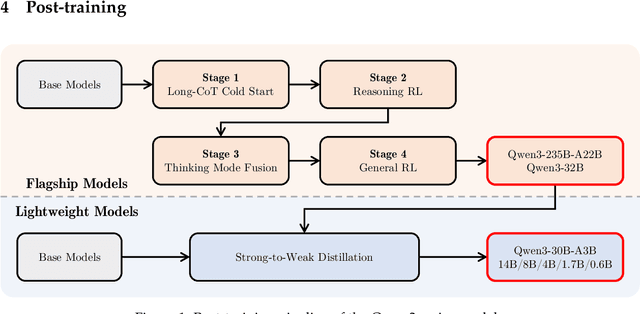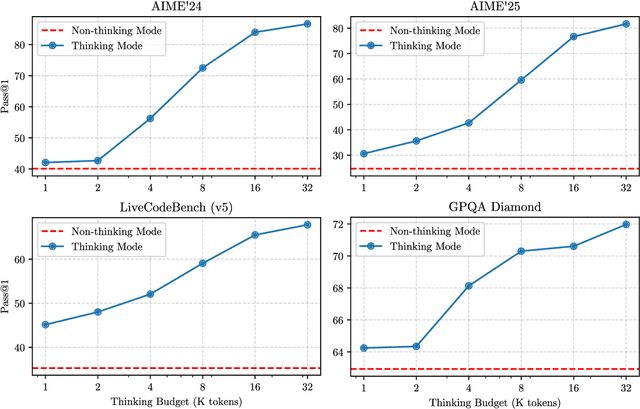Chang Gao
MANZANO: A Simple and Scalable Unified Multimodal Model with a Hybrid Vision Tokenizer
Sep 19, 2025Abstract:Unified multimodal Large Language Models (LLMs) that can both understand and generate visual content hold immense potential. However, existing open-source models often suffer from a performance trade-off between these capabilities. We present Manzano, a simple and scalable unified framework that substantially reduces this tension by coupling a hybrid image tokenizer with a well-curated training recipe. A single shared vision encoder feeds two lightweight adapters that produce continuous embeddings for image-to-text understanding and discrete tokens for text-to-image generation within a common semantic space. A unified autoregressive LLM predicts high-level semantics in the form of text and image tokens, with an auxiliary diffusion decoder subsequently translating the image tokens into pixels. The architecture, together with a unified training recipe over understanding and generation data, enables scalable joint learning of both capabilities. Manzano achieves state-of-the-art results among unified models, and is competitive with specialist models, particularly on text-rich evaluation. Our studies show minimal task conflicts and consistent gains from scaling model size, validating our design choice of a hybrid tokenizer.
EvHand-FPV: Efficient Event-Based 3D Hand Tracking from First-Person View
Sep 17, 2025Abstract:Hand tracking holds great promise for intuitive interaction paradigms, but frame-based methods often struggle to meet the requirements of accuracy, low latency, and energy efficiency, especially in resource-constrained settings such as Extended Reality (XR) devices. Event cameras provide $\mu$s-level temporal resolution at mW-level power by asynchronously sensing brightness changes. In this work, we present EvHand-FPV, a lightweight framework for egocentric First-Person-View 3D hand tracking from a single event camera. We construct an event-based FPV dataset that couples synthetic training data with 3D labels and real event data with 2D labels for evaluation to address the scarcity of egocentric benchmarks. EvHand-FPV also introduces a wrist-based region of interest (ROI) that localizes the hand region via geometric cues, combined with an end-to-end mapping strategy that embeds ROI offsets into the network to reduce computation without explicit reconstruction, and a multi-task learning strategy with an auxiliary geometric feature head that improves representations without test-time overhead. On our real FPV test set, EvHand-FPV improves 2D-AUCp from 0.77 to 0.85 while reducing parameters from 11.2M to 1.2M by 89% and FLOPs per inference from 1.648G to 0.185G by 89%. It also maintains a competitive 3D-AUCp of 0.84 on synthetic data. These results demonstrate accurate and efficient egocentric event-based hand tracking suitable for on-device XR applications. The dataset and code are available at https://github.com/zen5x5/EvHand-FPV.
Group Sequence Policy Optimization
Jul 24, 2025Abstract:This paper introduces Group Sequence Policy Optimization (GSPO), our stable, efficient, and performant reinforcement learning algorithm for training large language models. Unlike previous algorithms that adopt token-level importance ratios, GSPO defines the importance ratio based on sequence likelihood and performs sequence-level clipping, rewarding, and optimization. We demonstrate that GSPO achieves superior training efficiency and performance compared to the GRPO algorithm, notably stabilizes Mixture-of-Experts (MoE) RL training, and has the potential for simplifying the design of RL infrastructure. These merits of GSPO have contributed to the remarkable improvements in the latest Qwen3 models.
A Policy-Improved Deep Deterministic Policy Gradient Framework for the Discount Order Acceptance Strategy of Ride-hailing Drivers
Jul 16, 2025Abstract:The rapid expansion of platform integration has emerged as an effective solution to mitigate market fragmentation by consolidating multiple ride-hailing platforms into a single application. To address heterogeneous passenger preferences, third-party integrators provide Discount Express service delivered by express drivers at lower trip fares. For the individual platform, encouraging broader participation of drivers in Discount Express services has the potential to expand the accessible demand pool and improve matching efficiency, but often at the cost of reduced profit margins. This study aims to dynamically manage drivers' acceptance of Discount Express from the perspective of individual platforms. The lack of historical data under the new business model necessitates online learning. However, early-stage exploration through trial and error can be costly in practice, highlighting the need for reliable early-stage performance in real-world deployment. To address these challenges, this study formulates the decision regarding the proportion of drivers' acceptance behavior as a continuous control task. In response to the high stochasticity, the opaque matching mechanisms employed by third-party integrator, and the limited availability of historical data, we propose a policy-improved deep deterministic policy gradient (pi-DDPG) framework. The proposed framework incorporates a refiner module to boost policy performance during the early training phase, leverages a convolutional long short-term memory network to effectively capture complex spatiotemporal patterns, and adopts a prioritized experience replay mechanism to enhance learning efficiency. A simulator based on a real-world dataset is developed to validate the effectiveness of the proposed pi-DDPG. Numerical experiments demonstrate that pi-DDPG achieves superior learning efficiency and significantly reduces early-stage training losses.
OpenDPDv2: A Unified Learning and Optimization Framework for Neural Network Digital Predistortion
Jul 09, 2025Abstract:Neural network (NN)-based Digital Predistortion (DPD) stands out in improving signal quality in wideband radio frequency (RF) power amplifiers (PAs) employing complex modulation. However, NN DPDs usually rely on a large number of parameters for effective linearization and can significantly contribute to the energy consumption of the digital back-end in RF systems. This paper presents OpenDPDv2, a unified framework for PA modeling, DPD learning, and model optimization to reduce power consumption while maintaining high linearization performance. The optimization techniques feature a novel DPD algorithm, TRes-DeltaGRU, alongside two energy-efficient methods. The top-performing 32-bit floating-point (FP32) TRes-DeltaGRU-DPD model achieves an Adjacent Channel Power Ratio (ACPR) of -59.4 dBc and Error Vector Magnitude (EVM) of -42.1 dBc. By exploiting fixed-point quantization and dynamic temporal sparsity of input signals and hidden neurons, the inference energy of our model can be reduced by 4.5X while still maintaining -50.3 dBc ACPR and -35.2 dB EVM with 56% temporal sparsity. This was evaluated using a TM3.1a 200 MHz bandwidth 256-QAM OFDM signal applied to a 3.5 GHz GaN Doherty RF PA. OpenDPDv2 code, datasets, and documentation are publicly accessible at: https://github.com/lab-emi/OpenDPD.
TCN-DPD: Parameter-Efficient Temporal Convolutional Networks for Wideband Digital Predistortion
Jun 13, 2025Abstract:Digital predistortion (DPD) is essential for mitigating nonlinearity in RF power amplifiers, particularly for wideband applications. This paper presents TCN-DPD, a parameter-efficient architecture based on temporal convolutional networks, integrating noncausal dilated convolutions with optimized activation functions. Evaluated on the OpenDPD framework with the DPA_200MHz dataset, TCN-DPD achieves simulated ACPRs of -51.58/-49.26 dBc (L/R), EVM of -47.52 dB, and NMSE of -44.61 dB with 500 parameters and maintains superior linearization than prior models down to 200 parameters, making it promising for efficient wideband PA linearization.
AS-ASR: A Lightweight Framework for Aphasia-Specific Automatic Speech Recognition
Jun 06, 2025Abstract:This paper proposes AS-ASR, a lightweight aphasia-specific speech recognition framework based on Whisper-tiny, tailored for low-resource deployment on edge devices. Our approach introduces a hybrid training strategy that systematically combines standard and aphasic speech at varying ratios, enabling robust generalization, and a GPT-4-based reference enhancement method that refines noisy aphasic transcripts, improving supervision quality. We conduct extensive experiments across multiple data mixing configurations and evaluation settings. Results show that our fine-tuned model significantly outperforms the zero-shot baseline, reducing WER on aphasic speech by over 30% while preserving performance on standard speech. The proposed framework offers a scalable, efficient solution for real-world disordered speech recognition.
Qwen3 Technical Report
May 14, 2025



Abstract:In this work, we present Qwen3, the latest version of the Qwen model family. Qwen3 comprises a series of large language models (LLMs) designed to advance performance, efficiency, and multilingual capabilities. The Qwen3 series includes models of both dense and Mixture-of-Expert (MoE) architectures, with parameter scales ranging from 0.6 to 235 billion. A key innovation in Qwen3 is the integration of thinking mode (for complex, multi-step reasoning) and non-thinking mode (for rapid, context-driven responses) into a unified framework. This eliminates the need to switch between different models--such as chat-optimized models (e.g., GPT-4o) and dedicated reasoning models (e.g., QwQ-32B)--and enables dynamic mode switching based on user queries or chat templates. Meanwhile, Qwen3 introduces a thinking budget mechanism, allowing users to allocate computational resources adaptively during inference, thereby balancing latency and performance based on task complexity. Moreover, by leveraging the knowledge from the flagship models, we significantly reduce the computational resources required to build smaller-scale models, while ensuring their highly competitive performance. Empirical evaluations demonstrate that Qwen3 achieves state-of-the-art results across diverse benchmarks, including tasks in code generation, mathematical reasoning, agent tasks, etc., competitive against larger MoE models and proprietary models. Compared to its predecessor Qwen2.5, Qwen3 expands multilingual support from 29 to 119 languages and dialects, enhancing global accessibility through improved cross-lingual understanding and generation capabilities. To facilitate reproducibility and community-driven research and development, all Qwen3 models are publicly accessible under Apache 2.0.
Event-Based Eye Tracking. 2025 Event-based Vision Workshop
Apr 25, 2025Abstract:This survey serves as a review for the 2025 Event-Based Eye Tracking Challenge organized as part of the 2025 CVPR event-based vision workshop. This challenge focuses on the task of predicting the pupil center by processing event camera recorded eye movement. We review and summarize the innovative methods from teams rank the top in the challenge to advance future event-based eye tracking research. In each method, accuracy, model size, and number of operations are reported. In this survey, we also discuss event-based eye tracking from the perspective of hardware design.
RadMamba: Efficient Human Activity Recognition through Radar-based Micro-Doppler-Oriented Mamba State-Space Model
Apr 16, 2025Abstract:Radar-based HAR has emerged as a promising alternative to conventional monitoring approaches, such as wearable devices and camera-based systems, due to its unique privacy preservation and robustness advantages. However, existing solutions based on convolutional and recurrent neural networks, although effective, are computationally demanding during deployment. This limits their applicability in scenarios with constrained resources or those requiring multiple sensors. Advanced architectures, such as ViT and SSM architectures, offer improved modeling capabilities and have made efforts toward lightweight designs. However, their computational complexity remains relatively high. To leverage the strengths of transformer architectures while simultaneously enhancing accuracy and reducing computational complexity, this paper introduces RadMamba, a parameter-efficient, radar micro-Doppler-oriented Mamba SSM specifically tailored for radar-based HAR. Across three diverse datasets, RadMamba matches the top-performing previous model's 99.8% classification accuracy on Dataset DIAT with only 1/400 of its parameters and equals the leading models' 92.0% accuracy on Dataset CI4R with merely 1/10 of their parameters. In scenarios with continuous sequences of actions evaluated on Dataset UoG2020, RadMamba surpasses other models with significantly higher parameter counts by at least 3%, achieving this with only 6.7k parameters. Our code is available at: https://github.com/lab-emi/AIRHAR.
 Add to Chrome
Add to Chrome Add to Firefox
Add to Firefox Add to Edge
Add to Edge